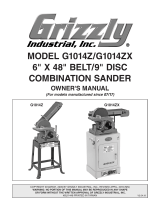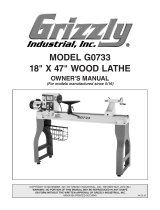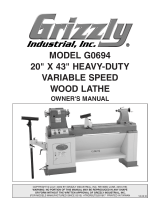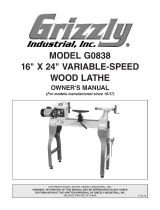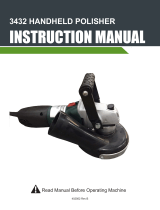Page is loading ...

COPYRIGHT © MAY, 2016 BY GRIZZLY INDUSTRIAL, INC.
WARNING: NO PORTION OF THIS MANUAL MAY BE REPRODUCED IN ANY SHAPE
OR FORM WITHOUT THE WRITTEN APPROVAL OF GRIZZLY INDUSTRIAL, INC.
#WK18140 PRINTED IN CHINA
MODEL T25942
PRO SANDING ROLLER
OWNER'S MANUAL
(For models manufactured since 04/16)

This manual provides critical safety instructions on the proper setup,
operation, maintenance, and service of this machine/tool. Save this
document, refer to it often, and use it to instruct other operators.
Failure to read, understand and follow the instructions in this manual
may result in fire or serious personal injury—including amputation,
electrocution, or death.
The owner of this machine/tool is solely responsible for its safe use.
This responsibility includes but is not limited to proper installation in
a safe environment, personnel training and usage authorization,
proper inspection and maintenance, manual availability and compre-
hension, application of safety devices, cutting/sanding/grinding tool
integrity, and the usage of personal protective equipment.
The manufacturer will not be held liable for injury or property damage
from negligence, improper training, machine modifications or misuse.
Some dust created by power sanding, sawing, grinding, drilling, and
other construction activities contains chemicals known to the State
of California to cause cancer, birth defects or other reproductive
harm. Some examples of these chemicals are:
• Lead from lead-based paints.
• Crystalline silica from bricks, cement and other masonry products.
• Arsenic and chromium from chemically-treated lumber.
Your risk from these exposures varies, depending on how often you
do this type of work. To reduce your exposure to these chemicals:
Work in a well ventilated area, and work with approved safety equip-
ment, such as those dust masks that are specially designed to filter
out microscopic particles.

Model T25942 (Mfd. Since 04/16) -1-
SECTION 1: SAFETY
For Your Own Safety Read Instruction Manual
Before Operating This Power Tool
The purpose of safety symbols is to attract your attention to possible hazard-
ous conditions. This manual uses a series of symbols and signal words which
are intended to convey the level of importance of the safety messages. The
progression of symbols is described below. Remember that safety messages by
themselves do not eliminate danger and are not a substitute for proper accident
prevention measures.
Indicates an imminent hazardous situation which, if
not avoided, WILL result in death or serious injury.
Indicates a potentially hazardous situation which, if
not avoided, COULD result in death or serious injury.
Indicates a potentially hazardous situation which, if
not avoided, MAY result in minor or moderate injury.
It may also be used to alert against unsafe practices.
This symbol is used to alert the user to useful infor-
mation about proper operation of the equipment.
NOTICE
Safety Instructions for Power Tools
OWNER’S MANUAL. Read and under-
stand this owner’s manual BEFORE using
machine.
TRAINED OPERATORS ONLY. Untrained
operators have a higher risk of being hurt
or killed. Only allow trained/supervised
people to use this power tool. When tool
is not being used, disconnect power, and
store in out-of-reach location to prevent
unauthorized use—especially around
children. Make workshop kid proof!
DANGEROUS ENVIRONMENTS. Do not
use tools in areas that are wet, cluttered,
or have poor lighting. Operating tools in
these areas greatly increases risk of acci-
dents and injury.
MENTAL ALERTNESS REQUIRED. Full
mental alertness is required for safe oper-
ation of power tools. Never operate under
the influence of drugs or alcohol, when
tired, or when distracted.
DISCONNECT POWER FIRST. Always
disconnect tool from power supply
BEFORE making adjustments, chang-
ing tooling, or servicing machine. This
prevents an injury risk from unintended
startup or contact with live electrical com-
ponents.
EYE PROTECTION.
Always wear ANSI-
approved safety glasses or a face shield
when operating or observing machinery to
reduce the risk of eye injury or blindness
from flying particles. Everyday eyeglasses
are not approved safety glasses.

Model T25942 (Mfd. Since 04/16)-2-
ELECTRICAL SAFETY. Tool plug must
match outlet. Double-insulated tools have
a polarized plug (one blade is wider than
the other), which must be plugged into a
polarized outlet. Never modify plug. Do
not use adapter for grounded tools. Use
a ground fault circuit interrupter if opera-
tion is unavoidable in damp locations.
Avoid touching grounded surfaces when
operating tool.
WEARING PROPER APPAREL. Do not
wear clothing, apparel or jewelry that
can become entangled in moving parts.
Always tie back or cover long hair. Wear
non-slip footwear to avoid accidental
slips, which could cause loss of workpiece
control. Wear hard hat as needed.
HAZARDOUS DUST. Dust created while
using tools may cause cancer, birth
defects, or long-term respiratory damage.
Be aware of dust hazards associated with
each workpiece material, always wear
a NIOSH-approved respirator, and con-
nect tool to an appropriate dust collection
device to reduce your risk.
HEARING PROTECTION. Always wear
hearing protection when operating or
observing loud machinery. Extended
exposure to this noise without hearing
protection can cause permanent hearing
loss.
REMOVE ADJUSTING TOOLS. Never
leave adjustment tools, chuck keys,
wrenches, etc. in or on tool—especially
near moving parts. Verify removal before
starting!
INTENDED USAGE. Only use tool for its
intended purpose. Never modify or alter
tool for a purpose not intended by the
manufacturer or serious injury or death
may result!
AWKWARD POSITIONS. Keep proper
footing and balance at all times when
operating tool. Do not overreach! Avoid
awkward hand positions that make tool
control difficult or increase the risk of
accidental injury.
SAFE HANDLING. Firmly grip tool. To
avoid accidental firing, do not keep finger
on switch or trigger while carrying.
FORCING TOOLS. Use right tool for job,
and do not force it. It will do job safer and
better at rate for which it was designed.
SECURING WORKPIECE. When
required, use clamps or vises to secure
workpiece. This protects hands and frees
both of them to operate tool.
GUARDS & COVERS. Guards and cov-
ers reduce accidental contact with mov-
ing parts or flying debris. Ensure they
are properly installed, undamaged, and
working correctly.
CHILDREN & BYSTANDERS. Keep chil-
dren and bystanders at a safe distance
from the work area. Stop using tool if they
become a distraction.
USE RECOMMENDED ACCESSORIES.
Consult this manual or manufacturer
for recommended accessories. Using
improper accessories will increase risk of
serious injury.
MAINTAIN WITH CARE. Keep cutting
tool edges sharp and clean. Follow all
maintenance instructions and lubrication
schedules to keep tool
in good work-
ing condition. A tool that is improperly
maintained could malfunction, leading to
serious personal injury or death. Only
have tool serviced by qualified service-
personnel using matching replacement
parts.
CHECK DAMAGED PARTS. Regularly
inspect tool for any condition that may
affect safe operation. Immediately repair
or replace damaged or mis-adjusted parts
before operating tool.
MAINTAIN POWER CORDS. When dis-
connecting cord-connected tools from
power, grab and pull the plug—NOT the
cord. Carrying or pulling the cord may
damage wires inside. Do not handle cord/
plug with wet hands. Avoid cord damage
by keeping it away from heated surfaces,
high traffic areas, harsh chemicals, sharp
edges, moving parts, and wet/damp loca-
tions. Damaged cords increase risk of
electrocution.
UNATTENDED OPERATION. Never
leave tool running while unattended. Turn
tool OFF and ensure all moving parts
completely stop before walking away.
EXPERIENCING DIFFICULTIES.
If at
any time you experience difficulties per-
forming the intended operation, stop
using the machine! Contact our Technical
Support at (570) 546-9663.

Model T25942 (Mfd. Since 04/16) -3-
Additional Safety Instructions for Roll Sanders
PROPER AT TACHMENTS. Only use
undamaged sanding/grinding/polish-
ing attachments that are rated for the
spindle size of this tool and designed
for the intended use. Attachments that
do not properly fit on spindle could fly
apart or come loose from tool during use
and strike you, causing serious injury or
blindness.
ATTACHMENT SPEED RATING.
Attachments operated at a faster speed
than rated for may break or fly apart and
strike you with great force. Before mount-
ing a new attachment, be sure the RPM
rating is equal to or higher than the speed
of this tool.
AVOIDING FIRE HAZARD. Do not use
near flammable/combustible materials.
Avoid overheating workpiece or sander to
reduce fire hazard.
CONTROLLING TOOL. Always use both
hands and maintain a firm grip on tool
during operations to prevent kickback
and avoid kickback-related injuries. Pay
special attention when working corners
and edges, as these operations have
greater tendency to produce kickback/
loss of control.
TRANSPORTING TOOL. Always turn tool
OFF and disconnect it from power while
carrying tool at your side. Otherwise,
accidental startup of tool could cause
spinning attachment to snag clothing,
pulling tool toward your body, causing
injury.
HAND/ATTACHMENT CONTACT.
Spinning attachments have the capability
of removing a lot of skin fast. Keep a firm
grip on the tool and position your hands
at a safe distance from attachment during
operation. Avoid wearing gloves, as they
may get caught in spinning attachment
and cause even more serious entangle-
ment injuries.
COMPLETING OPERATION. Always
wait for tool to come to a complete stop
before setting it down. Otherwise, spin-
ning attachment may grab surface or
other object and pull tool out of your con-
trol, causing personal injury or property
damage.
TOOL VENTILATION. Inspect and clean
tool air vent on a regular basis. Failure to
do so can cause overheating of motor,
tool failure, and electrical hazards.

Model T25942 (Mfd. Since 04/16)-4-
SECTION 2: INTRODUCTION
Foreword Contact Info
We stand behind our tools. If you have any
service questions, parts requests or gen-
eral questions about the product, please
call or write us at the location listed below.
Grizzly Technical Support
1815 W. Battlefield
Springfield, MO 65807
Phone: (570) 546-9663
Email: [email protected]
We want your feedback on this manual.
What did you like about it? Where could it
be improved? Please take a few minutes to
give us feedback.
Grizzly Industrial, Inc.
C/O Technical Documentation Manager
P.O. Box 2069
Bellingham, WA 98227-2069
Email: [email protected]
We are proud to offer this manual with your
new Model T25942 Pro Sanding Roller!
We've made every effort to be exact with
the instructions, specifications, drawings,
and photographs of the T25942 we used
when writing this manual. However, some-
times we still make an occasional mistake.
Also, owing to our policy of continuous
improvement, your Sanding Roller may
not exactly match the one shown in the
manual. If you find this to be the case, and
the difference between the manual and
your item leaves you in doubt, check our
website for the latest manual update or call
technical support for help.
For your convenience, we post all avail-
able manuals and manual updates for
free on our website at www.grizzly.com.
Any updates to your model of tool will be
reflected in these documents as soon as
they are complete.
Weight ...........................................................................................................................4 lbs.
Length x Width x Height ..................................................................................20 x 5
1
⁄2 x 3 in.
Horsepower .................................................................................................... 300W (0.4 HP)
Voltage ...........................................................................................................................120V
Phase ................................................................................................................Single-Phase
Amps ...............................................................................................................................2.5A
Speed ........................................................................................... Variable, 1600–3300 RPM
Spindle Diameter .......................................................................................................... 12mm
Spindle Length ............................................................................................................. 63mm
Number of Dust Ports ........................................................................................................... 1
Dust Port Size ................................................................................................................. 1 in.
Specifications

Model T25942 (Mfd. Since 04/16) -5-
SECTION 3: SETUP
Unpacking Inventory
Model T25942 Inventory (Figure 1)
A. Carrying Case .................................... 1
B. Pro Sand Roller Tool ......................... 1
C. Hex Wrench 4mm .............................. 1
D. 80-Grit Flap Wheel, 2
5
⁄16" x
7
⁄16" ......... 1
E. 80-Grit Flap Wheel, 2
5
⁄16" x 2
3
⁄8" ........ 1
F. Sanding Drum with
80-Grit Sanding Sleeve, 1
3
⁄4" x 2
3
⁄8" . . 1
Figure 1. Model T25942 inventory.
B
C
D
E
F
A
Your tool was carefully packaged for
safe transportation. Remove the packag-
ing materials from around your tool and
inspect it. If you discover the tool is dam-
aged, please immediately call Customer
Service at (570) 546-9663 for advice.
Save the containers and all packing mate-
rials for possible inspection by the car-
rier or its agent. Otherwise, filing a freight
claim can be difficult.
When you are completely satisfied with
the condition of your shipment, inventory
the contents.
If any non-proprietary parts are missing
(e.g., a nut or a washer), we will gladly
replace them; or for the sake of expedi-
ency, replacements can be obtained at
your local hardware store.
This tool presents serious injury
hazards to untrained users. Read
through this entire manual to
become familiar with the controls
and operations before starting the
tool!

Model T25942 (Mfd. Since 04/16)-6-
Test Run
Before installing attachments and using
your Model T25942, test run the tool to
make sure it runs properly.
If, during the test run, you cannot easily
locate the source of an unusual noise or
vibration, stop using the tool immediately,
then review the Troubleshooting guide
on Page 14.
If you still cannot remedy a problem, con-
tact our Tech Support at (570) 546-9663
for assistance.
To test run tool:
1. Read all safety instructions at begin-
ning of manual.
2. Make sure switch is in OFF position.
3. Connect tool to power source.
4. Hold tool firmly with both hands with
one thumb resting on ON/OFF switch.
5. Use your thumb to move switch lock
sideways to unlock ON/OFF switch,
then push ON/OFF switch forward to
turn tool ON (see Figure 2). Keep your
hand poised over switch in case you
need to quickly turn tool OFF.
6. With tool running, carefully move speed
control dial (see Figure 2) from "1" to
"6", and then back down to "1".
7. Listen and watch for abnormal noises
or actions.
— Investigate strange or unusual nois-
es and correct them before operat-
ing tool. Always switch tool OFF
and disconnect it from power before
investigating or correcting problems.
8. Turn tool OFF.
9. Attempt to move ON/OFF switch for-
ward without first sliding switch lock
sideways.
— If the tool does not start, the switch
locking feature is working.
— If the tool does start, switch it OFF.
The switch locking feature is not
working. This safety feature must
work properly before proceeding.
Call Tech Support for help.
ON/OFF
Switch
Switch
Lock
Speed Control
Dial
Move Switch
Lock Sideways
Move ON/OFF
Switch Forward
Figure 2. Location of ON/OFF switch and speed control dial.

Model T25942 (Mfd. Since 04/16) -7-
SECTION 4: OPERATIONS
Tool Operation Tips
In addition to the safety instructions in this
manual, the most important safety con-
sideration is to use common sense at all
times. What may be okay in one situation
may not be safe in another.
Here are some tips to keep in mind
while using this tool:
• Always be sure the attachment is
secured on the spindle by tightening
the spindle flange screw.
• Always keep one thumb poised over
the ON/OFF switch during operations,
in case you need to quickly turn tool
OFF.
• Work against the direction of spindle
rotation to maintain optimum control of
tool. Working in the same direction as
the rotation can cause the tool to lunge
or fly out of your hands.
• Concentrate on the task at hand. STOP
operations if other people are distract-
ing you or your mind is on something
else.
Damage to your eyes and lungs could
result from using this tool without
proper protective gear. Always wear
safety glasses and a dust mask/res-
pirator when operating this tool.
Loose hair and cloth-
ing could get caught
in tool and cause seri-
ous personal injury.
Keep loose clothing
and long hair away
from moving parts.
If you have never used this type
of tool or equipment before, WE
STRONGLY RECOMMEND that you
read books, trade magazines, or get
formal training before beginning any
projects. Regardless of the content
in this section, Grizzly Industrial
will not be held liable for accidents
caused by lack of training.

Model T25942 (Mfd. Since 04/16)-8-
Removing/Installing
Attachments
The Model T25942 Pro Sanding Roller
comes with three sanding attachments: a
2
5
⁄16" x
7
⁄16" 80-Grit flap wheel, a 2
5
⁄16" x 2
3
⁄8"
80-Grit flap wheel, and a sanding drum with
a 1
3
⁄4" x 2
3
⁄8" 80-Grit sanding sleeve.
Flap wheels are composed of many sand-
ing flaps that can follow the contours of a
workpiece. They are well suited for light
sanding and can achieve a more "feath-
ered" result. Examples:
• Sanding thin layers of paint
• Sanding radiused edges and corners
• Light, touch-up sanding
Sanding drums with sleeves are rigid and
less "forgiving." They are well suited for
aggressive sanding and produce a more
precise, defined edge. Examples:
• Sanding paint/glue build-up
• Sanding sharp edges and corners
• Aggressive, rough sanding
Do not make adjustments to tool while
it is connected to power. Turn tool
OFF and disconnect it from power
before attempting to install, remove,
or adjust any components.
Tool Needed:
Hex Wrench 4mm ..................................... 1
To remove/install attachment:
1. DISCONNECT TOOL FROM POWER!
2. Press spindle lock button to prevent
spindle rotation during next step (see
Figure 3).
3. Remove spindle flange screw (see
Figure 3), and remove attachment.
4. Slide replacement attachment onto
spindle (see Figure 3).
5. Thread spindle flange screw into end
of spindle, then press spindle lock
button as you fully tighten screw (see
Figure 3).
Figure 3. Attachment installation/removal
components.
Spindle Lock
Button
Attachment
Spindle Flange
Screw

Model T25942 (Mfd. Since 04/16) -9-
Using Dust CollectionPositioning Dust
Shroud
The Model T25942 Pro Sanding Roller
is equipped with a dust shroud (see
Figure 4) that can be positioned accord-
ing to the needs of the operation.
To adjust the position of the dust shroud,
loosen the dust shroud adjustment knob,
rotate the dust shroud to the desired
position, then re-tighten the knob (see
Figures 4–5).
Figure 4. Location of dust shroud adjust-
ment components.
Dust Shroud
Knob
Dust
Shroud
The dust shroud is equipped with a 1"
dust port that can be connected to a shop
vacuum or other dust collection system for
added respiratory safety.
To connect your tool to a dust collection
system, your system must be equipped
with 1" fittings, or alternatively, you can use
a length of 1" hose and an adapter, such
as Model W1039 Universal Adapter (see
Accessories on Page 11).
Connect the 1" dust collection hose to
the dust port of your tool (see Figure 6),
then connect the other end of the hose
to your shop vacuum or dust collector,
using the appropriate reducers/adapters,
if necessary.
Note: Always secure hoses with hose
clamps.
Figure 6. Dust hose connected to 1" dust
port.
1" Dust Port
To use a dust collection system during
operation, first turn your dust collection
system ON, then turn your tool ON, and
begin operation.
When you are finished with your operation,
turn your tool OFF, then turn your dust col-
lection system OFF.
Figure 5. Dust shroud rotated to new
position.
Dust Hose

Model T25942 (Mfd. Since 04/16)-10-
Operating Tool
Read and follow all of the proceeding
Safety and Operations instructions
before using your tool.
To operate tool:
1. Secure workpiece, if necessary, to pre-
vent it from moving or shifting during
operations.
2. Make sure ON/OFF switch (see
Figure 7) is in OFF position, to prevent
accidental startup, then connect tool to
power.
3. Use speed control dial (see Figure 7)
to select appropriate speed for opera-
tion. The dial is marked "1–6," which
corresponds to the following speeds:
• 1–2 Low
• 3–4 Medium
• 5–6 High
Figure 7. Tool controls.
4. Use your thumb to move switch lock
sideways to unlock ON/OFF switch,
then push ON/OFF switch forward to
turn tool ON (see Figure 7). Make sure
your hand stays poised over switch in
case you need to quickly turn tool OFF.
5. When finished with operation, turn tool
OFF, and disconnect it from power.
ON/OFF
Switch
Switch
Lock
Speed Control
Dial
Move Switch
Lock Sideways
Move ON/OFF
Switch Forward

Model T25942 (Mfd. Since 04/16) -11-
SECTION 6: ACCESSORIES
order online at www.grizzly.com or call 1-800-523-4777
T27117—Turbo II HEPA Dust Extractor
This powerful wet and dry dust extractor is
equipped with tool-coupling, for automatic
suction every time you turn your tool on.
The high performance turbine provides a
151 cfm (71 l/s) flow rate and 98.4" of water
lift (245 mbar vacuum) yet with a quiet
volume of 66 dB.
Figure 9. T27117 Turbo II HEPA Dust
Extractor.
Figure 8. W1039 Universal Adapter.
W1039—Universal Adapter
This adapter provides a multitude of reduc-
ing options. Simply cut off unneeded steps.
Outside diameter sizes include 1", 2", 2.5",
3", 4", 5", and 6". Wall thickness is
1
⁄8".
Basic Eye Protection
T20501—Face Shield Protector 4"
T20502—Face Shield Protector 7"
T20503—Face Shield Window
T20451—Clear Safety Glasses
T20452—Anti-Reflective S. Glasses
H7194—Bifocal Safety Glasses 1.5
H7195—Bifocal Safety Glasses 2.0
H7196—Bifocal Safety Glasses 2.5
Figure 10. Basic eye protection.
T20502
T20503
H7194
T20452
T20451
Figure 11. Half-mask respirator with
disposable cartridge filters.
H2499—Small Half-Mask Respirator
H3631—Medium Half-Mask Respirator
H3632—Large Half-Mask Respirator
H3635—Cartridge Filter Pair P100
If you work around dust everyday, a half-
mask respirator can be a lifesaver. Also
compatible with safety glasses!

Model T25942 (Mfd. Since 04/16)-12-
SECTION 7: MAINTENANCE
!
Always DISCONNECT POWER before
servicing, adjusting, or doing main-
tenance to reduce the risk of acci-
dental injury or electrocution.
For optimum performance, routinely check
the condition of the following items and
repair or replace them as necessary:
• Worn sanding sleeve/attachment.
• Clogged/dirty motor vent.
• Loose components/attachments.
• Worn switch.
• Worn or damaged cords and plugs.
• Any other condition that could ham-
per the safe operation of this tool.
Cleaning Motor Vent
The motor vent (see Figure 12) provides
ventilation to the motor and helps to pre-
vent it from overheating. After prolonged
use, the vent may become dirty and
clogged, and require cleaning.
To clean the vent, use a shop vacuum to
vacuum out the opening.
Figure 12. Location of motor vent.
Motor Vent

Model T25942 (Mfd. Since 04/16) -13-
Figure 14. Removing sanding sleeve.
Keep Spindle
Locked
Slits in Drum
3. Press spindle lock button to prevent
spindle rotation during following steps
(see Figure 14).
Note: If spindle does not lock right
away, rotate it while pressing spindle
lock button until button engages with
spindle and locks it.
4. With spindle locked, rotate sanding
sleeve in direction of slits in sand-
ing drum, while simultaneously pulling
sleeve off of drum (see Figure 14).
5. With spindle still locked, slide a new
sanding sleeve onto sanding drum,
while simultaneously rotating sleeve in
direction of slits.
6. Re-install dust shroud and secure it
with dust shroud knob.
Removing/Replacing
Sanding Sleeve
The sanding sleeve can be removed from
the sanding drum and replaced with a
new sleeve according to the needs of your
operation.
Tool Needed:
Hex Wrench 4mm ..................................... 1
Figure 13. Location of dust shroud and
dust shroud knob.
Dust Shroud
Knob
Dust Shroud
To remove sanding sleeve:
1. DISCONNECT TOOL FROM POWER!
2. Remove dust shroud knob, then
remove dust shroud (see Figure 13).

Model T25942 (Mfd. Since 04/16)-14-
SECTION 8: SERVICE
Symptom Possible Cause Solution
Tool will not start;
fuses or circuit
breakers blow.
1. Wall circuit breaker tripped.
2. Plug/receptacle at fault.
3. Switch lock engaged.
4. ON/OFF switch at fault.
5. Wiring open/has high
resistance.
6. Short circuit in motor or loose
connections.
7. Motor at fault.
1. Ensure circuit size is correct;
reset/replace breaker.
2. Test for good contacts; cor-
rect the wiring.
3. Slide switch sideways to
unlock switch (Page 10) or
replace switch.
4. Test/replace switch.
5. Check/fix broken, discon-
nected, or corroded wires.
6. Inspect connections on
motor for loose or shorted
terminals or worn insulation.
7. Test/repair/replace.
Tool slows/stops. 1. Motor overloaded.
2. Short circuit in motor or loose
connections.
1. Clean motor, let cool, and
reduce load on motor.
2. Inspect connections on
motor for loose or shorted
terminals or worn insulation.
Tool has vibration
or noisy operation.
1. Sanding attachment not
properly installed.
2. Dust shroud is loose.
3. Sanding sleeve is worn/
frayed and slipping on drum
or slapping dust shroud.
1. Properly install sanding
attachment and tighten
flange screw (Page 8).
2. Tighten dust shroud
(Page 9).
3. Replace sanding sleeve
(Page 13).
Troubleshooting
Motor & Electrical
Review the troubleshooting and procedures in this section if a problem develops with your
tool. If you need replacement parts or additional help with a procedure, call our Technical
Support.

Model T25942 (Mfd. Since 04/16) -15-
Symptom Possible Cause Solution
Sanding grains
easily rub off sleeve
or flap wheel.
1. Sanding sleeve/flap wheel
has been stored in an incor-
rect environment.
2. Sanding sleeve/flap wheel
has been crushed or bent.
1. Store sanding sleeve/flap
wheel in a cool, dry area;
replace.
2. Prevent sanding sleeve/flap
wheel from being crushed or
bent; replace.
Deep sanding
grooves or scars in
workpiece.
1. Sanding sleeve/flap wheel
too coarse for desired finish.
2. Workpiece sanded across
the grain.
3. Too much sanding force on
workpiece.
4. Tool held still for too long
while sanding.
1. Use finer grit sanding sleeve/
flap wheel.
2. Sand with grain.
3. Reduce pressure on
workpiece while sanding.
4. Keep tool moving while
sanding.
Sanding sleeve/flap
wheel clogs quickly.
1. Too much sanding force on
workpiece.
2. Sanding softwood.
3. Sanding sleeve/flap wheel
worn or damaged.
1. Clean sanding sleeve/flap
wheel, and then reduce pres-
sure on workpiece while
sanding.
2. Use different stock, or accept
characteristics of stock and
plan to clean/replace sanding
sleeve/flap wheel frequently.
3. Replace sanding sleeve
(Page 13)/flap wheel
(Page 8).
Glazed sanding
surface.
1. Sanding wet stock.
2. Sanding stock with high
amount of residue.
3. Sanding sleeve/flap wheel
clogged or worn.
1. Only sand stock with mois-
ture content below 20%.
2. Use different stock, or accept
characteristics of stock and
plan to clean/replace sanding
sleeve/flap wheel frequently.
3. Clean/replace sanding
sleeve/flap wheel.
Burn marks on
workpiece.
1. Sanding grit too fine.
2. Using too much pressure.
3. Tool held still for too long
while sanding.
4. Sanding sleeve/flap wheel
clogged or worn.
1. Use coarser grit sanding
sleeve/flap wheel.
2. Reduce pressure on
workpiece while sanding.
3. Keep tool moving while
sanding.
4. Clean/replace sanding
sleeve/flap wheel.

Model T25942 (Mfd. Since 04/16)-16-
Carbon Brushes
The Model T25942 is equipped with a pair
of carbon brushes that are NOT designed
to be user-serviceable or replaceable. The
brushes shown in the parts breakdown are
for reference purposes only and are NOT
available for purchase.
As with all similarly constructed tools, the
carbon brushes are considered to be a
regular "wear" item. In other words, they
will eventually wear out and will do so in
direct proportion to overall tool use (or
abuse). As such, brush wear is NOT cov-
ered under warranty. However, when used
with care, this tool will provide an extended
level of service and brush wear will be
relatively slow.

Model T25942 (Mfd. Since 04/16) -17-
1
2
3
4
4
4
5
6
7
8
9
10
11
11
12
13
14
15
16
17
17
18
19
20
21
22
23
24
25
26
27
28
29
32
33
32
34
35
36
37
38
39
40
41
42
43
44
48
49
45
46
47
SECTION 9: PARTS
Main
We do our best to stock replacement parts when possible, but we cannot guaran-
tee that all parts shown are available for purchase. Call (800) 523-4777 or visit
www.grizzly.com/parts to check for availability.

Model T25942 (Mfd. Since 04/16)-18-
Main Parts List
REF PART # DESCRIPTION
1 PT25942001 SPINDLE FLANGE SCREW M5-.8 X 10
2 PT25942002 SANDING DRUM 1-3/4 X 2-3/8"
3 PT25942003 SPINDLE
4 PT25942004 BALL BEARING 608ZZ
5 PT25942005 GEAR 18T
6 PT25942006 GEAR 11T
7 PT25942007 BALL BEARING 606ZZ
8 PT25942008 HEX NUT M4-.7
9 PT25942009 LOWER SHAFT HOUSING (ALUMINUM)
10 PT25942010 KNOB BOLT M4-.7 X 8, 14D X 15L
11 PT25942011 BALL BEARING 605ZZ
12 PT25942012 TRANSMISSION SHAFT (LONG)
13 PT25942013 GEAR 42T
14 PT25942014 UPPER SHAFT HOUSING (ALUMINUM)
15 PT25942015 LOCK WASHER 3MM
16 PT25942016 PHLP HD SCR M3-.5 X 10
17 PT25942017 BALL BEARING 607ZZ
18 PT25942018 TRANSMISSION SHAFT (SHORT)
19 PT25942019 GEAR 39T
20 PT25942020 ROTOR
21 PT25942021 HOUSING (UPPER)
22 PT25942022 TAP SCREW M4 X 16
23 PT25942023 POWER CORD 18G 2W 72" 5-15P
24 PT25942024 CABLE SLEEVE
25 PT25942025 CABLE CLAMP
26 PT25942026 TAP SCREW M4 X 12
27 PT25942027 CIRCUIT BOARD
28 PT25942028 ROCKER SWITCH GREE KCD1 10A 125V
29 PT25942029 STATOR
32 PT25942032 CARBON BRUSH ASSEMBLY
33 PT25942033 SWITCH CONNECTOR
34 PT25942034 HOUSING (LOWER)
35 PT25942035 SWITCH ACTUATOR
36 PT25942036 COMPRESSION SPRING 0.6 X 6 X 6.8
37 PT25942037 SWITCH PIN 3 X 20
38 PT25942038 SWITCH LOCK
39 PT25942039 E-CLIP 4MM
40 PT25942040 COMPRESSION SPRING 0.5 X 8.3 X 9.5
41 PT25942041 SPINDLE LOCK BUTTON
42 PT25942042 U-SHAPE CERAMIC PLATE
43 PT25942043 DUST SHROUD W/1" PORT
44 PT25942044 SANDING SLEEVE 1-3/4 X 2-3/8", 80-GRIT
45 PT25942045 E-CLIP 3MM
46 PT25942046 MACHINE ID LABEL
47 PT25942047 HEX WRENCH 4MM
48 PT25942048 FLAP WHEEL 2-5/16" X 2-3/8", 80-GRIT
49 PT25942049 FLAP WHEEL 2-5/16" X 7/16", 80-GRIT
/


